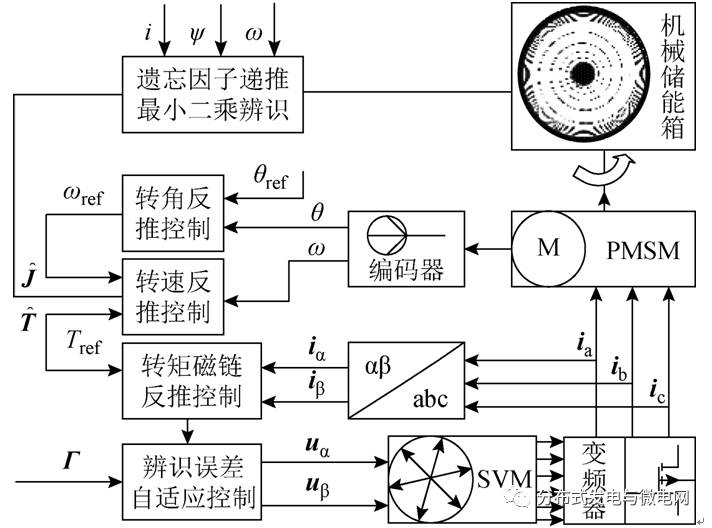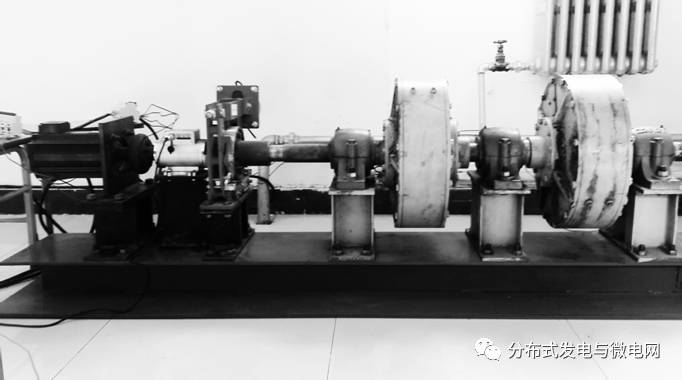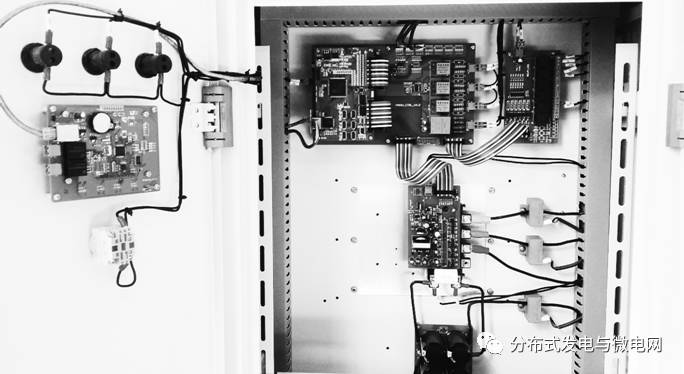The mechanical elastic energy storage system continuously changes the torque and moment of inertia of the motor load during the energy storage process. The situation is complicated, and a control system capable of quickly tracking its changes and having strong anti-interference ability is needed. The direct torque control has fast response and can quickly track the energy of the energy storage box. Combined with the backstepping adaptive control algorithm, it can have better steady state and transient performance. Firstly, the forgetting factor recursive least squares algorithm is used to identify the energy storage box torque and moment of inertia, and the control object parameters are updated in real time. Combined with the identification results, the corner, speed, torque and flux linkage controller are designed, and the stator voltage is finally obtained. The components in the two-phase stationary coordinate system are simultaneously designed with the torque and moment of inertia adaptive controller to eliminate the influence of the identification error on the control performance. The voltage space vector modulation method is further applied to generate a constant frequency switching signal to control the inverter operation. The experimental results show that the output torque of the permanent magnet synchronous motor can quickly track the load torque, and the torque and speed ripple is small, and the energy storage process is stable. Energy storage technology is a key core technology for peaking and frequency modulation, building a smart grid and securing intermittent new energy into the network. It plays a huge role in the four links of power system transmission, transmission, distribution and use. The mechanical elastic energy storage system is here. Under the circumstances, it came into being. The energy storage component of the mechanical elastic energy storage system is a mechanical elastic energy storage box, and its internal structure is a spiral spring installed side by side. The conversion and storage of electrical energy to mechanical elastic potential energy is realized by the driving of the permanent magnet synchronous motor. During the energy storage process, the torque and moment of inertia of the energy storage box are continuously changing. In particular, the reverse acting torque of the energy storage box gradually becomes larger as the energy storage process progresses. If the motor output torque cannot be quickly matched, it may result in storage. The energy box reverses with the motor and damages the motor. At the same time, the time-varying characteristics of the moment of inertia may cause chattering of the motor speed, affecting the mechanical properties of the energy storage box and destroying the stability of the energy storage process. As a large-scale rigid mechanical component, the scroll spring requires a permanent magnet synchronous motor (PMSM) to operate at a low speed and low speed. Direct Torque Control (DTC) uses torque as the control target, fast response, easy tracking of load torque, and easy implementation. However, when the conventional DTC is running at low speed, the torque and flux linkage are large, which is not conducive to the smooth progress of the energy storage process, and there is a disadvantage that the inverter switching frequency is not constant. The usual solution is to further subdivide the stator voltage vector. The pulsation is reduced by increasing the number of voltage vectors and refining the effect time of each voltage vector, but it leads to an increase in hardware cost and a more complicated control system. The magnetic link ring and the torque loop are designed respectively. The stator voltage reference value is obtained by the PI regulator, and the switching state of the inverter is controlled by the method of Space Vector Modulation (SVM), but considering the strong PMSM. Coupling, multivariate and continuous time-varying characteristics of the control object of the system, PI parameters are often difficult to set, and the stability margin is small, and the adaptive ability of the system is not strong. The combination of the reverse thrust control method and the SVM-DTC control method is particularly suitable for the control of a nonlinear system of a permanent magnet synchronous motor, but its low speed control of a large inertia time varying load is not further described. For the output characteristics of mechanical elastic energy storage box, this paper firstly uses the forgetting factor least squares recursive identification algorithm to identify the time-varying torque and moment of inertia of the energy storage box, and updates the control object parameters in real time. Secondly, combined with the identification result, the design angle and speed are designed. Torque and flux linkage reverse controller. At the same time, in order to eliminate the influence of identification error on the control system, an adaptive control method is introduced to make the system have strong autonomy. Finally, the voltage space vector modulation method is applied to generate a constant frequency switch. Signal to control inverter operation. The experimental results show that the motor output torque can respond quickly to the change of the energy storage box torque. The identification error and the moment of inertia change have less adverse effects on the system, the torque and speed chattering are smaller, and the energy storage system can run smoothly at low speed. Complete the conversion of electrical energy to mechanical elastic potential energy. Figure 3 control system block diagram Figure 4 Mechanical elastic energy storage system Figure 5 Mechanical elastic energy storage system control device in conclusion Firstly, the mathematical model of mechanical elastic energy storage system is established. Based on the model, the mathematical derivation of the inverse SVM-DTC theory is completed. The global convergence of the method is proved. The method is validated by experiments. Sex. It can be seen from the experimental results that compared with the conventional method, the mechanical elastic energy storage system adopting the method is more stable at low speed operation, the motor torque tracking matching is more rapid, and the steady state and transient performance of other parameters are more excellent. It provides an effective method for mechanical elastic energy storage systems. RAM/RFM Middle Frequency Water Cooled Capacitors RAM/RFM Middle frequency water cooled capacitors Water Cooled Capacitors,Medium Frequency Capacitor,Intermediate Frequency Capacitors YANGZHOU POSITIONING TECH CO., LTD. , https://www.cndingweitech.com

